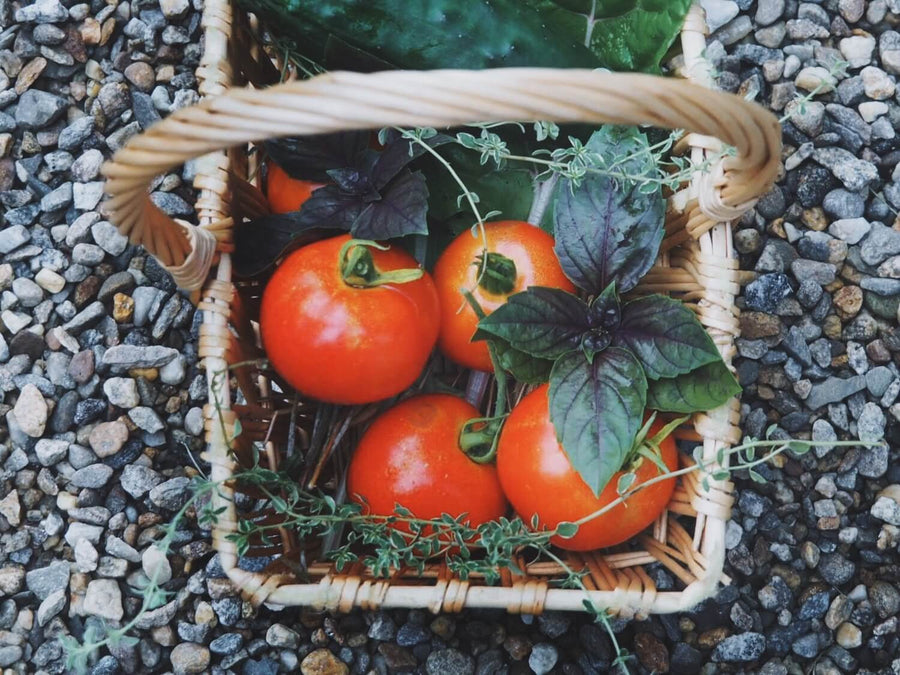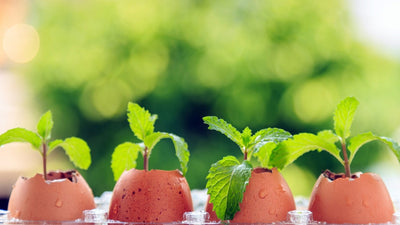
Tomatoes are no doubt one of my favorite things to grow in the garden. They're relatively easy to manage and a delicious home-grown snack for adults and kids alike. One of my favorite memories from last summer was watching my daughter carefully inspect her little tomatoes and eat them right off the vine as soon as they had ripened. For a two year old growing up in the city, it was one of the first hands-on experiences of learning that food doesn't just appear on our plates, but takes time and care to cultivate, and we can play a vital role in its creation. She was often eager to water her plants and began to take ownership, as much as a two year old can, in the process of growing her own little snacks. It's also worth noting that she hardly ate tomatoes when they were served on a plate with a meal, but she would eat every last red fruit straight from the stem! Hence the saying "if you want your kids to eat veggies, grow them!"

Whether you live among the hustle and bustle of a city or have plenty of outdoor space at home but aren't sure what to do with it, tomatoes are a great way to get growing. There are a few tricks to growing them successfully, and throughout the process, you'll learn all about what tomato plants need in order to thrive. Here's everything you need to know about growing a bounty of vine-ripe tomatoes bursting with flavor!
Where to plant
Tomatoes are perfect plants for small, edible gardens because they do well in containers as well as garden beds, and the varieties are truly endless. Whether you're starting from seed or purchasing a seedling, look for a variety that is best suited for your hardiness zone. Tomato plants of all kinds love sun, so be sure to plant them in an area where they'll receive full sun all day long. If you're planting in containers, choose 3-gallon pots or something larger. Tomatoes tend to have an extensive root structure and are more productive when their root systems are not restrained.
Choosing the best soil
Tomatoes like well-draining, nitrogen-rich soil. This means extra compost, blood-meal or crushed eggshells will make them happy. You want to make sure they have a steady source of calcium carbonate throughout the growing season, which is exactly what eggshells are made up of! Taking the time to add these extra sources of nutrients to your soil before planting also helps to regulate the soil's acidity level to the plant's liking.

Staking, caging or trellising
Your tomato plants will need a support structure such as tomato cages or wooden stakes. It's best to put this structure in place before getting your plants into the ground so that you don't disturb their root systems later. Personally, I tend to stake my tomatoes with a single bamboo shoot per plant and tie them with soft Velcro ties.
Planting Tips
As with all plants, you'll want to encourage your tomato plants to have strong, healthy root systems. This can be done by trimming down the lower part of your seedlings and planting them deep into the soil. I usually add peat moss to the root area to help with water retention and add a source of extra nitrogen––in this case, some crushed Pete & Gerry's Organic eggshells.
Watering
Tomato plants like to be moist but not soaking wet, so water them accordingly. As noted above, you can use peat moss when planting to help with water retention. Mulching is also a great practice to help keep the moisture levels high and wards of invasive weeds. As a general rule of thumb, it's better to water in the early mornings or evenings when the sun is not at its peak to minimize evaporation.
Depending on where you live, your tomato plants may need to be watered daily, twice a day, or every other day. Summer heat waves and dry regions can dry out your plants quickly, so be sure to check the soil daily to determine whether the plants need additional water. If you live in a rainy or humid area, your plants may not require water as often. Indoor or outdoor potted plants should be watered daily to keep the soil moist.
Feeding for optimal growth
Throughout the growing season, I tend to add a sprinkle of compost or plant food at the root of the plants every 1-2 weeks. This helps them grow to their full potential increases productive. Compost can be purchased at your local garden supply store, but homemade is even better!
Pinching suckers
Tomato plants send out suckers (the little shoots that grow between your main stem and an already established secondary stem). If you remove these suckers, your plant will focus on more robust growth and production.
Harvesting
Harvesting your tomatoes is as simple as picking them right off the vine or removing the entire vine with a pair of scissors or garden shears. Tomatoes are their most delicious and sweet when allowed to ripen on the vine, so pick them off your plant once they turn a deep red color. You can continue harvesting your tomato plant all summer long and enjoy them as a nutritious snack or in your shakshuka.




